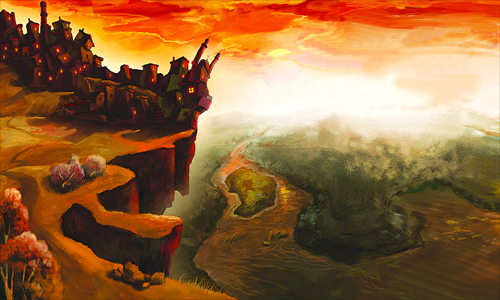1001 Uyghur nights
By Lu Qianwen Source:Global Times Published: 2012-11-27 20:10:05

Cover art for the animated One Thousand and One Nights Photo: Courtesy of Pahridin
Historically an important link on the Silk Road, Xinjiang Uyghur Autonomous Region in China's northwest frontier bears a certain cultural resemblance to its bordering regions and even more with middle and western Asia that share the same Muslim roots. Today, due to the region's fast technological development, Uyghur cultural enterprises are exerting their influence not just within the country, but also westward.
One of the most internationally popular examples of Arabic culture is an ancient collection of folk tales from Arab countries known as One Thousand and One Nights. Now this symbolic cultural heritage will be produced into an animated series, according to a news release by Qarluq Media Tech Company in Xinjiang this month.
On Iranian TV
"There will be a total of 104 episodes divided into four parts. The first 26 episodes will be broadcast both in Iran and China in 2014," said Pahridin Qarluq, president of the company. He noted the project is a cooperative effort between his company and the Iranian company Alphabet Holdings, a leading investment company in the country.
"A joint venture will be established in Iran and officially start operation in March next year, and our company will hold 60 percent of the stakes," said Pahridin. "It will not just be responsible for the production of One Thousand and One Nights animated series, but other extended products like related movies and video games," he told the Global Times.
Established in 2008, Qarluq Me?dia is a digital animation production and software development company. Though still young - with its founder, Pahridin, born in the 1980s - the company is rising rapidly across the country through its products. With a subsidiary in Shanghai, it offers products like 360-degree movie production for museums and studios to inner Chinese regions.
As for the cooperation this time with Iran, Qarluq Media will mainly be responsible for the technology and production, and Iran's Alphabet Holdings will be in charge of release in the region.
"While the first 26 episodes (at 24 minutes each) are being broadcast in Iran in 2014, domestic audiences will also be able to watch them through television stations, some of which are still holding discussions," said Pahridin. And for the rest of the 78 episodes, he added, each of them will be broadcast along its production.
Advantages
According to their agreement, 80 million yuan ($12.85 million) will be invested into the animated series production and a total of 360 million yuan ($57.82 million) into the development of related products and digital production.
The domestic average cost for a 24-minute animation is around 300,000 to 400,000 yuan, but for each episode of One Thousand and One Nights, that number is estimated to be between 600,000 and 700,000 yuan.
"This does not only underline their trust in us, but also proves the competitiveness of animated enterprises in Xinjiang," said Pahridin.
Apart from the animation series, the joint venture operation in Iran will also involve the technology de-velopment of intelligent information systems, Internet and social network platforms, and animated educational software.
"As the main successor of the Persian civilization, Iran has a strong cultural and artistic influence in the Middle East and even the western region of China," said Pahridin, "There are some cultural similarities between Xinjiang and places in Iran."
The culture of Xinjiang is deeply influenced by exotic Persian culture. The religion of Islam, which most Arab countries follow, was popularized in Xinjiang between the years 900 and 1000. And now the area's population of Uyghurs, which occupy the largest ethnic group in Xinjiang taking 46 percent of the total, believe in Islam.
Besides the consideration of art and culture, politics is also an inevitable factor in cooperation with Iran. "Our country has enjoyed a stable relationship with Iran, so the cooperation is more secured," said Pahridin.
Going Westward
Testing the waters for the first time in a foreign market, Qarluq plans to set its foot further into middle and western Asian countries.
"I believe we set a good example of service outsourcing, with the head?quarters in the country focusing on technology development and our subsidiaries in other markets in charge of product release and channels," said Pahridin.
Just as the 18th National Congress of the Communist Party of China stressed, while being held in Beijing earlier this month, domestic cultural enterprises are encouraged to go out and improve their competitiveness.
Hence comes the question of how. Many of those going out are currently in the form of cultural exchanges, or are government backed and lack the ability to use marketing power. Examples like Qarluq Media undoubt-edly offer a good reference.
"The most important factor in this case is not the investment, but a referable way for the development of animated enterprises in Xinjiang," said Sheng Jun, deputy head of the industry office of the Cultural Department of Xinjiang Uyghur Autonomous Region.
"The certain resemblance in culture and art shared between Xinjiang and places in middle and western Asia gives our local animated enterprises more competitiveness compared to those in Japan and Western countries, since our production suits local culture better and is easier to be accepted," said Sheng.
"Meanwhile on the other hand, compared to their local animation companies in those countries, our enterprises have a technological advantage, (so) we should exert our influence outwardly," Sheng added.
However, though hosting ample cultural symbols and bearing resemblance with Islamic culture, few Xinjiang cultural companies have tried westward before.
With different national conditions and sensitive geographic situations in the region where other Chinese enterprises have learned their lessons before, signing contract is just a start for Qarluq.
Posted in: Film